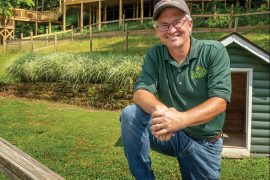By James E. Casto
HQ 8 | SUMMER 1991
It could have been called Switzer Park. For that matter, except for a fortunate change in plans, it might have been home to a municipal incinerator. But it became Ritter Park and over the years it has proven to be one of Huntington’s best known and loved landmarks. Its 100 or so acres on Huntington’s historic South Side are a green, tree-lined oasis that attracts thousands of visitors every week in every season of the year.
From early spring through the heat of the Huntington summer and on into the fall, Ritter welcomes the softball players and the soccer fans, the Frisbee throwers and the sunbathers, the picnickers and the leisurely strollers.

Each season has its own partisans in the ranks of those who love the park, but it’s certainly difficult to imagine a more pleasant vista than 13th Avenue in the fall. The stately trees that march down the park side of the thoroughfare stretch their limbs skyward, seemingly so high their tops are out of sight.Their green canopies have turned to vivid shades of red, orange and yellow and the leaves, when they fall to the ground, make a wonderful crackling noise as you scuff your way through them. Across the street can be glimpsed the handsome homes – including the official residence of Marshall University’s president – that have the park as their front yard.
During winter, after a heavy snow, Ritter’s 12th Street hill is closed to traffic and both children and adults converge on it, pulling their inner tubes and sleds, while the park’s open areas become white battlefields for snowball warriors.

Then one day, almost without warning, 01′ Man Winter packs his bags and slips out of town. Spring arrives, its annual appearance heralded by the many colorful dogwoods that dot the park. Thus, the annual cycle of the seasons goes, and it’s difficult to imagine there was ever a time when Ritter – its well-tended grassy meadows, its wonderful trees, its handy benches, the creek and the bridges that span it- hasn’t been part of the Huntington scene. But, believe it or not, there was a time – not so many years ago – when all this was open country, rarely visited and even less, appreciated. And, as they say, thereby hangs a tale.
The Ritter Park story had its beginnings in the early years of the century. Oddly enough, Rufus Cook, the Boston surveyor who was hired by Collis P. Huntington to lay out the rail baron’s new town, made no provision for a public park anywhere in his plans. So, as early as 1881, agitation for a public park began in Huntington. That year saw the town council vote to issue $7,000 in bonds to purchase three city blocks between 7th and 8th Streets north of the Chesapeake & Ohio Railway’s tracks. But in a referendum election the voters turned thumbs down on the idea.

Later, Huntington himself proposed to sell – not give, mind you, but sell – some land along the railroad tracks east of 14th Street for use as a park. But again the voters said no. Why? The public records don’t tell us. Maybe it was the money. Maybe just a matter of politics. There is no way of saying with any certainty.
The city’s early years saw other proposals advanced for creation of a park, including the acquisition of land along the north side of 3rd Avenue east of 16th Street (Hal Greer Boulevard), where the Marshall University campus is today. Nothing came of those dreams either.
But in 1908, a city councilman by the name of Rufus Switzer was among those involved in the city’s purchase of 5 5 acres of land on Four Pole Creek south of 13th Avenue between 8th and 12th Streets. The land was earmarked as the future site of a city incinerator. But Switzer had a better idea.

Born in Cabell County in 1855, Switzer taught school as a young man, then earned a law degree at the University of Virginia. He first practiced law in Winfield, W. Va., but in 1891 moved back to Huntington, where he quickly became involved in civic affairs and politics, winning a seat on city council. He would go on to serve two terms as Huntington mayor, was a director of the First Huntington National Bank, and one of the city’s most successful businessmen. Throughout his life he donated money to a wide variety oflocal causes, and on his death in 1947 he bequeathed the entire annual income of his considerable estate to continue that work. The Huntington Galleries, now the Huntington Museum of Art, might never have been established were it not for Rufus Switzer’s generosity.
But that’s getting ahead of the story.
At a city council meeting, Switzer proposed that the land which had been purchased as an incinerator site be used instead as the city’s first public park. Hard as it may be to believe today, Switzer’s proposal met strong opposition, with critics charging that the tract was too far outside the city. However, Switzer fought hard for his idea, and at one point he even offered to buy the land from the city at the price it had paid for it- $18,000.

By 1909, with Switzer now installed as mayor, he eventually prevailed. Along the way, the idea of using the land as a park had gained an important supporter, businessman Charles Lloyd Ritter who was building an imposing estate on a hill south of the city. Ritter didn’t welcome the idea of having the city incinerator down the hill from his home. So he offered to deed the city an additional 20 acres if the land was used as a park with a road running though the property. The city took him up on his offer and, though the name was never officially adopted, Ritter Park was born.
Switzer, re-elected mayor in 1909, recruited a well-known New Jersey landscape architect, J.T. Withers, to prepare a master plan for the new park. But before work could start, Switzer was defeated in a bid for a 3rd term as mayor.
The new administration abandoned the proposed plan, and over the next few years the efforts for park development were unsuccessful.
One effort was a lake named “Chaposcanwe,” a coined word made up of the first letters of the names of four men who were then city commissioners. Located on the north side of Four Pole just east of 10th Street, the lake was little more than a mud hole. After a child drowned, it was drained and abandoned.

The development of Ritter Park as we know it today mostly dates from the establishment of the Huntington Board of Park Commissioners in 1925. With the late George S. Wallace at its helm, the board presided over a Ritter Park where decades of Huntingtonians could enjoy the beauty of the beautifully cared for and nationally known Rose Garden, picnic in the rugged surroundings of the Lion’s Den, or play tennis. Oldsters enjoyed a seemingly endless game of croquet, and although park rules said softball and football were officially forbidden, youngsters routinely violated that prohibition, while keeping a wary eye out for the park patrolman.
However, by the 1970s, the grand old park was badly showing its age. In 1979, James McClelland, a native of Mount Lebanon, Pa., boasted 16 years of experience in parks and recreation in his hometown and was named director of Huntington’s park system. One of his first steps on arriving in Huntington was to convince the park commissioners to undertake a long overdue study of Ritter Park and its future needs. Ritter’s impressive size and central location were wonderful assets, McClelland told the commissioners, but it was time “to revitalize and rejuvenate” it.
As a result, the decade of the 1980s brought major changes to old Ritter. A one-mile jogging track was created in a more or less oval shape bordered by 8th Street, 13th Avenue, 12th Street and Four Pole and quickly became one of the park’s most popular features. Nodding and saying “Hi there!” to friends and neighbors encountered on the Ritter pathway is now a familiar ritual for many Huntingtonians.

The park’s amphitheater was refurbished, a new picnic shelter constructed, and an innovative children’s playground developed on the site of old Lake Chaposcanwe. “There’s nothing like it anywhere,” says McClelland of the playground. “It’s one of a kind.” Its most striking feature: stone triangles, columns and arches that seem like king-sized versions of children’s toy blocks. The stone shapes can be a fort, a pirate ship, a space capsule – or anything else a young mind can imagine.
Now under construction in the Lion’s Den area are four additional tennis courts and on the drawing board is a tennis facilities building which, when combined with the new courts, would make Ritter an ideal setting for tennis tournaments.
However, the changes at Ritter have not been without controversy. Plans for the new tennis center call for closing 12th Street to through traffic, a move opposed by many residents of 8th Street hill. C.L. Ritter’s gift of land to the park that bears his name was on condition the road be built.

“But nobody then could look in the future and see the conditions today,” says McClelland. “It’s not so much that we need the land for the tennis facility itself. It’s the safety problem. With more and more people using the courts, we’re afraid somebody’s going to be hit by a car.”
Accordingly, the Greater Huntington Park and Recreation District has gone to court, asking that the deed stipulation regarding the road be set aside. Unhappy residents are fighting the move. A judge eventually will decide the issue.
Looking ahead, McClelland hopes to improve the Rose Garden – now a regular stop for visiting tour buses and, during spring and summer months, the scene of at least one or two outdoor weddings every week. “We need to introduce some new varieties of roses,” says McClelland. “And there’s a need for some shade somewhere. On a warm day, it can get really hot up there.”

And Ritter’s trees are very much on McClelland’s mind: “It’s the trees that make the park. And too many of ours are way past their prime. They’re dead or dying. As we lose them we’ve got to do a better job of replacing them.”
Planting a new rose bush or replacing a dying tree might seem mundane tasks but they’re an essential part of the stewardship necessary to protect the beauty that is Ritter Park and ensure that it continues to be what it’s been since Rufus Switzer first envisioned it – one of Huntington’s crown jewels.




